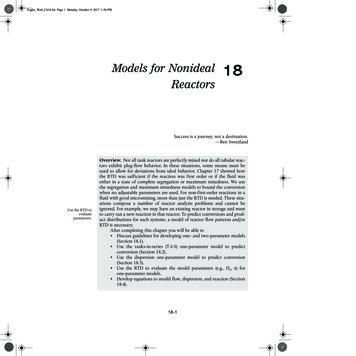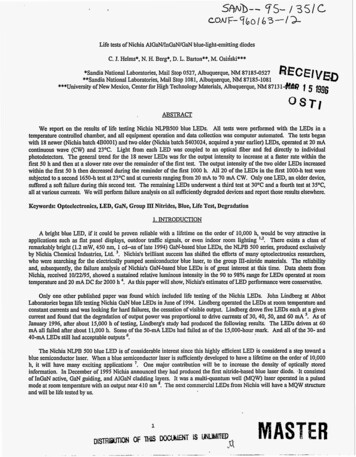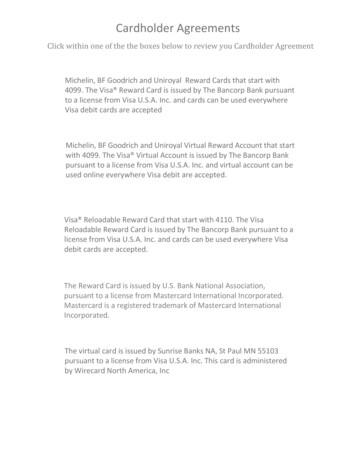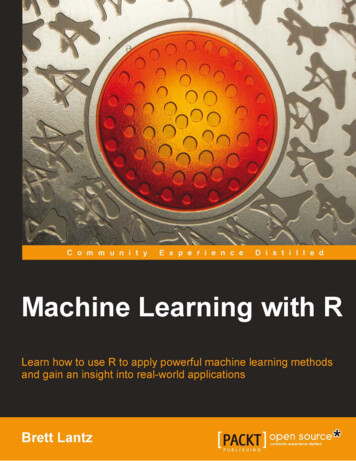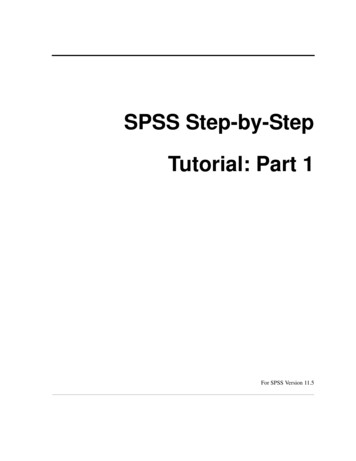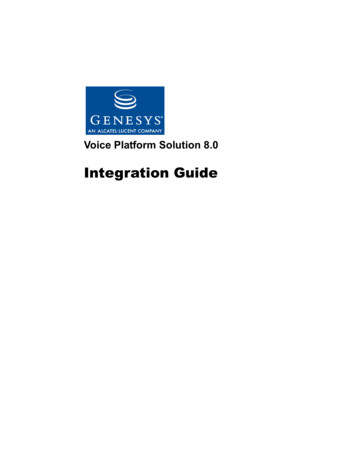
Transcription
News UpdateUniroyal installing reactorsNichia releases samplesfor manufacturing HES-LEDs of commercial blue laserUNIROYAL TechnologyCorp is installing threeEMCORETurboDisc reactors to manufacture highbrightnessblueandgreen LEDs, as part of ajoint venture betweenthe companies. The systems will be capable ofproducing 200 millionhigh brightness LEDs peryear at full capacity.Uniroyal ,entered intoan agreement with EMCORE last fmancial yearto acquire technology forthe manufacture of epitaxial wafers used inhigh brightness LEDs.The companies ‘also entered into a joint venture,managedbyUniroyal, whereby thepartners are near completion of a 25 millionstate-of-the-art facility forthe manufacture of highbrightnessLEDsinTampa, FL, USA.The facility, upon completion, willbe one of the largest single-site LED manufacturers in North America.The joint venture isfocusing on blue andgreen high brightnessLEDs, but will produce afull array of colours including high brightnessred, orange and yellow.Commercial production at the facility is expected to begin in thethird quarter of 1999.The market for HB-LEDsis tipped to reach US lbillion by 2003 from anestimated 386 millionin ,1998. Applications include automotive lighting, traffic signals andoutdoor signs.Uniroyal owns Convertible Preferred Stockof EMCORE that, uponconversion,represents6.4% of the company.Uniroyal Technology;tel: l-941-361-2100;Pax: 1-941361-2214.NICHIA Chemical Industries Ltd (Tokushima) hascontinued its leadershipin the race to commercialize the blue laserwith the release of trialsamples of InGaN-basedviolet laser diodes.The laser diodes havean output power of 5mw, an emission wavelength of 400 run, an operating current of 40 mAand operating voltage of5 V. The lifetime of thedevices is 10 000 hoursat room temperature.The diodes promiseto win a number of major applications fromhigher capacity opticalstorage devices and higher-resolution laser printers, to more precise lasersurgery.Reflecting the importante of the devices,Nichia’s chief researcher,Shuji Nakamura, is con-tinuing to win a numberof major awards for hisblue laser developments.Among the latest majorprizes conferred to himand his research groupare a 1998 C&C Prizeand a 1998 Rank Prizefor Optoelectronics.Both awards recognized Nakamura’s effortsin pioneering efforts inthe development of GaNbased lasers. Included inboth awards was DrIamu Akasaki of MeijoUniversity, while Professors Hiroshi Amano, also of Meijo University,and JacquesPankove(University of Colorado)were included for theirpioneering work on theRank Prize citation.Turn to pages 30-35for more Nichia updates.Nichia Chemical; telz 81 88é222311;fax: 81-884210148.EMC6RE forms joint venture to produce white LEDSEMCORE’ Corp (Somerset, NJ, USA) has formed anew joint venture withGE Lighting targetingwhite light LEDs r devices tipped to reachsales, of US 1 billionwithin the next decade.The new company,GELcore LLC, will develop and market a range ofboth white and colouredLEDs for automotive, traffit, flat panel display andother speciality lightingapplications. It expects tobegin commercial production in the second4lil-VS Reviewhalf of 1999 at the newfacility in Tampa, FL, USA.This facility is a joint venture between EMCOREand Uniroyal (sec abovestory).GELcore will produceproprietary LEDs by converting GaN-based blueemitters to white lightthrough the combinationof phosphors and plastics. Under terms of theagreement, GE Lightingwill hold a 51% interestin GELcore. It is also acquiring a capita1 positionin EMCORE.Vol.12 No. 1 1999?EMCORE is also enjoying success with its GaAssolar cell technology, having just entered into afour-year agreement withSpace Systems/Loml(SS/L)to supply its satellite programme. The agrement,effective once EMCOREcompletes SS/Ls spacequaliiìcation and test procedures, includes an initial order with a value inexcess of 5 million.Deliveries of the solarcells are expected tocommence in the secondquarter of 1999.In other news, EMCORE has posted a netloss of 6.1 million forthe fust quarter of fiscal1999. Revenue for thequarterended31December1998was 10.1 million, down 18%on the same period ayear ago. The recentspate of agreements withmajor partners is part ofthe strategy to return thecompany to profit, EMCORE says.EMCORE Corp; tel: l732-271-9090;faxz l732-271-9686.
News UpdateKopin to double device wafer manufacturingKOPIN Corp (Taunton,MA, USA) is to double itsmanufacturing capacity forits GaAs HBT devicewafer products in response to growing demandfiom digitalcellularphones,high speed SONET networks and other communication devices.Kopin has orderedmultiple device waferproduction systems, aswel1 as additional waferprocessing and characterization equipment, toexpand its device waferproduction capacity. Delivery and installation ofthe production systemswill be in 1999 and 2000,with the equipment taking the company’s capacity to more than 80 0004” wafers per year. DrJohn Fan, Kopin’s presi-AIXTRON begins building10 000 m2 production plantAIXTRON AG has completed the fìrst phase ofits capita1 expansionstrategy, with the opening of a fìve-storey building at its headquarters inAachen, Germany. The2800 m* building wil1house the company’s research and developmentactivities, as wel1 as thesales and the service departments.AIXTRON has nowmoved onto the secondphase of the programme,announced at the timeof its initial public offering, which will see a10 000 m* manufacturingplant built near its existing facilities in Aachen.The plant, which wil1bring a ten-fold increaseon current productioncapacity when completed, wil1 be built in threestages. The first stage isscheduled to open in thethird quarter of 1999.In its most recent fìnancialresults,theMOCVD equipment maker reported third quarterrevenues of DM31 mil-lion (LJS 18.4 million)and pre-tax protìts ofDM7.8 million. In linewith the strong performance in this quarter,AIXTRON has adjustedupwards its forecasts forfull-year sales to DM106million, which wouldrepresent an increase of36% on the previousyear.AIXTRON has enjoyed particularly strongsales in Taiwan, where ithas won more than 16contractors in the pastyear, primarily for the delivery of large scale GaNand AlGaInP productionsystems for the manufacture of UHB-LEDs. Neworders have come fromUnited Epitaxy Corp(UEC), Epistar Corp,Visual Photonics Epitaxy(VPEC), Opto-Electronics& Systems ), and other LEDmanufacturers.ALXTRON AG; tel: 49241 K9-0; fax: 49 2418909-40.dent and CEO, says theinvestment is due in partto an overall shift in theGaAs integrated circuitmarket to HBT based solutions from more traditional technologies.“These high performance HBT circuits eliminate the need for manyof the support circuits required by other technologies, thereby providing acapacitysimpler, lower tost solution”, he says.“We believethe addition of this newcapacity, coupled withour materials technology,will enable US to continue to lead the rapidlygrowing market for GaAsHBT device wafers,” headds.Kopin Corp; tel: l-508824-6696fax: l-508826958.QED continues productionexpansion in 1999AFTER increasing outputby 40% in 1998, merchant epiwafer supplierQuantum Epitaxial Designs Inc (QED) is planning for a further 50% increase in 1999.To support the expansion, QED (Bethlehem,PA, USA) wil1 soon takedelivery of VG Semicon’slatest production system,the V150. QED expectsthe new system, whichhandles multiple 6” GaAswafers, wil1 arrive inApril and be fully operational by mid-year.The Vl50 will offer asignificant expansion inQED’s capabilities. QEDcurrently operates fourVl00 systems and twosingle wafer reactors andis enjoying an increasingmarket share in the merchant epiwafer business.In addition to MESFETand HEMT material, QEDis developing an impressive HBT and laser diodecapability. “The Vl50 offers US a big step in capacity at a crucial pointin QED’s growth”, com-mented Torn Hierl, QED’sfounder and president. “Itwill help US fulfii ourcommitment to providethe highest quality epiwafer while enhancingthe value of our product.”David Williams, managing directer of VGSemicon says the Vl50had reached the marketat a time of growing demand. “Continuing expansion of wireless apwidelyplicationsisforecast and VG Semiconis determined to maintain our position by providing superior, technically advanced products,”he says.In other news, QEDhas recently promotedDr Keith Evans to vicepresident of opemtionsresponsible for directingthe manufacturing andengineering departments.Prior to his new responsibilities, Evans was director of new technologies.QED Inc; tel: lólO-%l6930; fax: 1410-&15273.Ill-VS Review?Vol.12 No. 1 19995
News UpdateCdTe technologyreceives funding boostITNEnergySystems(ITN) has won a threeyear, US 733 166 contract for the development and commercialization of CdTe thin filmsolar technology.The company, basedin Denver, CO, hasreceivedtheawardfrom the National EnergyResearchLaboratory(NREL) under its ThinFilm Partnership programme.ITN specializes in themanufacture of thin filmusing proprietary chemical vapour depositiontechnology developed byits founder Dr MohanMisra.ITN also holds a 50%interest in Global SolarEnergy LLC, another towin a contract under theprogramme. It will receive 1 698 232 over threeyears to develop largearea, thin film copper indium gallium diselenide(CIGS) photovoltaics.The grants are part of 60 million NREL hasawarded to US companies to speed the development of photovoltaicpromisecells, whichmuch lighter and moreeffìcient solar cells thatcould be produced rol1to roll like a newspaper.ITN Energy Systems; tel: 1-303-298X)37.TRW opens space powerproduction facilityTRWInc(RedondoBeach, CA, USA) hasopened a solar array production facility to meetthe growing demand forits space systems and forthose of other manufacturers of satellites andsatellite constellations.The 9300 m* TRWSpace Power ProductionFacility (SPPF) at thecompany’s Space Parkcampus contains customdesignedautomatedequipment for interconnecting, testing and inspecting solar cells, aswell as assembling products. The facility usessoftware developed byTRW to control solar array manufacturing andinspectionequipment,and to operate a realtime inventory controland data collection management system. It is designed to accommodateboth crystalline siliconand GaAs solar cells ofany size, without changing equipment or tooling.TRW says the new facility not only reduceslabour costs and reducessolar cell attrition rates,but also increases its annual capacity by a factorof three which is equivalent to 25 typical geosynchronous satellites.TRW Space & Electronies Group; tel: l310-812-4721.Osram and Siemensform opto ventureSIEMEN’s SemiconductorGroup (HL) has formed ajoint venture with OsramGmbH to produce optoelectronic devices.Based in Regensburg,Germany, the joint venture began operation on1 January 1999 under thename OSRAM Opto Semiconductors GmbH (OHG).Osram, als0 a Siemens’subsidiary, has a majorityinterest of 5 1% and wil1assume management ofthe new company. With aworkforce of 2300, thejoint venture plans togenerate DM350 millionin sales during its fìrst, incomplete (nine months)fìscal year.Theoptoelectronicactivities exclusively pursued by Siemens Semiconductors to date willbe assumed by the newjoint venture. This stepwil1 enable HL, whichwill become an independent company in 2000,to focus on its core business, while continuing toenjoy the growing market success of its optoelectronics business. ForOsram, oneof theworld’s threelargestlamp manufacturers, thismove into the future-oriented field of LED technology has far-reachingstrategie implications.HL wil1 contribute itscurrent business in LEDs,infraredcomponents,power lasers and displays. These activities also include marketing anddevelopment in Regensburg and Cupertino (CA,USA) as wel1 as chip production in Regensburgand assembly in Malaysia.To ensure continuity incustomer relations, thejoint venture wil1 continue to use sales channelsemployed by SiemensSemiconductors. Osramwill give the joint venture greater access to themarket for lighting applications.The lamp mantiacturer also has special expertise in electronic lightingsystems as wel1 as in materials such as glass andfluorescent substances,which are increasinglybeing used in LED production.HL recentlyintroduced a white LED insurface mount device(SMD) technology featuring luminescente intensities of 20 med. A secondgenerationisexpected in early 1999providing intensities of60-80 med.Siemens AG; tel: 49-8963628480; faxz 49-8963620402.BusinessSienwns AG has ’ &XBSXI a new subsidiary,PWW&H, toSiC wafers.The company will he@ Siemens frr&s &arts to commercialize SiC devices for a w#f high temperature andether electronic applica&ns.lil-VS ReviewVol. 12 No. 1 1999?7
News UpdateLasing in powders offers LED challengeSCIENTISTS at Northwestern University (Evanston, IL, USA) have demonstrated lasing in asimple powdered material, suggesting that semiconductorlasers mayeventuallybemadecheaply enough to replace LEDs. The Northwestern team showedthat powdery layers ofZn0 and GaN can produce blue laser lightwhen it is pumped withlight from another laser.The observation was reported in the 21 December 1998 issue ofApplied Pbysics Letters.Unlike traditional solid state lasers the powdered zinc oxide layerhas a highly disorderedstructure, which the re-8Hl-VS ReviewVol.12?searchers were able toshow enhanced the lasing effect. “We’re exploiting what had been seenas a drawback,” researcher Hui Cao said. “Peoplehave been trying to eliminate scattering, whichyou always think of asbad for a laser. But wewent to the other extreme. In a totally disordered medium, scatteringis very strong, and it actually helps lasing becauseit forms closed-loop pathsfor the light and createsfeedback. It makes itsown laser cavities.”When they pumpedthe zinc oxide layer witha conventional laser atlow power, the teamfound that the materialgave off light with aNo. 1 1999broad band of wavelengths. But as the pumppower was increased, thebands sharpened, andabove a certain threshold, very sharp frequencybands appeared. The narrow frequency range ofthose bands and theirstrong polarization confirmed that the light wasin fact a laser emission.Cao said that the random orientation of theself-formed laser cavitiesin the film is also an advantage because it makesthe laser output omnidirectional.“Traditionallasers are highly directional, while LEDs shinein all directions,” shesaid. “But if a Zn0 laserdevice ultimately works,it could replace LEDs inluminescent display devices, because the lightwould go in all directionsbut with much greater efficiency. A laser at thesame power consumption could be 1000 timesbrighter than an LED,’she said.In separate Northwestern news, the university has received tìnalpatent approval for theworld’s smallest laser, amicrocavity semiconductor laser.Northwestern’s Tiansfer Technology Programhas awarded NanovationTechnologies Inc (Miami,Fl, USA) exclusive worldwide licensingrightsto these devices andtheir underlying technologies.
Nms UpdateTriQuint furthers alliance withBoeing for IC design servicesTRIQUINTSemiconductor (Hillsboro, OR,USA) is combining itsGaAs IC foundry serviceswith the third-party ICdesign services of BoeingCo (Seattle,WA, USA).Under the agreement,the two companies willwork together to providecustomers with turn-keyGaAsASIC services.Customers, while contracting with TriQuint,wil1 have access to, andbesupportedby,Boeing’s IC design team.TriQuint will then movethe design into production providing manufacturing, packaging andtesting services. Whilethe TriQuinVBoeing relationship has existed formore than 10 years, thisis the first time the combined services have beenoffered in the merchantmarket.“The purpose of thisagreement: says BruteFoutnier, vice presidentof TriQuint’s FoundryServices Division, “is toopen up new options forcustomers with GaAs re-CommercialGaAs MOSFETsa step closerquirements, but withoutthe design resources tobring their IC ideas to reality. There simply arenot many options opento a customer wishing tobring moderate volumeGaAs ICs to production,”he says. “We are providing a path which protects a customer’s intellectual property, whileoffering proven designand production manufacturing capabilities.”TrlQuint Semiconductor;tel: l-503 615-9000;fa.x l-503-615-8900.Bel1 labs advance quantum cascade laserSCIENTISTS at Bel1 Labs(Murray Hill, NJ, USA),the R8zD arm of LucentTechnologies, have demonstrated the first semiconductor laser that cansimultaneously emit lightat multiple widely separated wavelengths.The experimental newlight source does thework of three conventional semiconductor lasers, each with a hundredtimes less power. It emitslight in the invisible region of the spectrum,where most gases andvapours leave telltalelight-absorptionfingerprints, and could find important applications inareas such as polIutionand environmental monitoring, industrial processcontrol, and medical diagnostics. It is not a communications laser.Grown by MBE, thequantum cascade laserconsists of alternatinglayers of AIInAs andGaInAs. Under operatingconditions, a current injection causes electronsto cascade through 25stages of the new material. This cascade schemeboosts the power of thelaser to high levels, witha peak power of 100 mWemitted at wavelengthsof 6.6 ,um and 8.0 pm.Afurther increase of thecurrent generates an additional laser wavelengthat 7.3 pm. The threewavelengths can be further tuned by changingthe temperature of thelaser. Details of the workwere published in the 26November 1998 issue ofNature.Meanwhile, FedericoCapasso,head of Bell Iab’sSemiconductorPhysicsResearch Department anda member of the team,has received a further honour for his work in developing the quantumcascade laser. Capasso,along with Jerome Faist,Rudolf E Kazarinov, andRobert A. Suris, wereawarded a 1998 RankPrize for Optoelectronicsfor their work on the devices.In quantum cascadelasers the wavelength isentirely determined bythe thickness of the active layers rather than bythe chemical composition of the material. Inthis way, a huge wavelength region can becovered using the samematerial, and a singlelaser can simultaneouslyemitmultiplewavelengths.BELL Labs researchershave moved closer to developing commerciallyviable GaAs MOSFETs,devices that promise cellular phones with longerbattery lives and morepowerful wireless basestations.At the recent ‘IEEEInternationalElectronDevices Meeting (IEDM)‘,the researchers announeed they had made further advances in perfecting the gate oxidematerial needed to produce MOSFETs. Buildingon earlier work, the Bel1Labs team has improvedthe stability and electrical characteristics of thegate oxide, comprised ofgalliumoxideandgadolinium oxide.As a result, the current decreases only 1.5%after 150 hours of operation under extreme conditions. The previouslybest research results reported a 22% drop overa three hour period.“After we fnrther improve the gate oxide material, GaAs MOSFET devicesmay be veryattractive for various applications, such as cellular phones, wireless basestations and potentiallymicroprocessors in computers,” says Bel1 Labs researcher Ming-HweiHong.CommercialGaAsMOSFETs would offer astrong challenge to theirMESFETcounterparts, dueto their lower power consumption requirements.Hl-VS ReviewVol.12 No. 1 1999?9
Neus UpdateAnadigics teams with HP EEsof to improve design toolsANADIGICS (Warren, NJ,USA) has teamed withHP EEsof, to developand enhance electronicdesign automation (EDA)tools to improve R&Defficiency Working withHP Advanced DesignSystem from HP EEsof,engineers at both companies are sharing information on product designand software capabilities.The partnership’s keyareas of focus includeimproving package modelling (critical in RFdesigns), training and integration.Long termgoals of collaboration includeadvancingtheconcept of virtual sampling, the ability to supply a software sampleCdSe crystals hold promiseas fluorescent probesSOME of the more shadowy secrets of biology maysoon be illuminated through the use of fluorescent probes based on compound semiconductors.Scientists with the USDepartment of Energy’sLawrence Berkeley National Laboratory (LBNL)and the University ofCalifornia at Berkeleyhave developed nanometre-sized crystals of semiconductors, including CdSe and CdS, that can beused as fluorescent probesfor the study of biological materials.They offer adistinct advantage overconventional dye-molecules in that they emitmultiple colours of light,which means they canbe used to label and measure several biologicalmarkers simultaneously.The unique opticalthesepropertiesofnanocrystals als0 hint atthe possibility of observing changes that takeplace in labelled biological systems, over a period of time.10Hl-VS ReviewIn fluorescent labeling, markers, usually antibodies that attach themselves to specific proteins,are tagged with dye-molecules that fluoresce oremit a specifìc colour oflight when stimulated bylaser light, usuaIly Erom aconfocalmicroscope.“Sometimes, in order tofully characterize a sample, a population of cells,for example, you need tolook at combinations ofmarkers”, says ProfessorPaul Alivisatos.“Such measurementsrequire multiple-colourlight emissions whichare diffcult to obtainwith conventional dyemolecules. Ideal probesfor multi-colour experiments should emit atspectrally resolvable energies, should have a narrow, symmetrie emissionspectrum, and the wholefamily should be excitable at a single wavelength”, he says.Prof. Alivisatos,LBNL;tel: l-5106437371;fax: l-510642-6911.Vol.12 No. 1 1999?that represents a hardware circuit, which isseen as an importantin reducing time tomarket for new products.Inotherrecentdevelopments, Anadigicsplans to accelerate thequalibcation of its stateof-the-art 6” wafer fabrication facility and hasadopted a ‘Share Purchase Rights Plan’ (see“III-VS confrontthenew millennium”, pp. 1820).The company is alsoexamining new technologies such as HBTs andSiGe.Anadigics; telz l-90&6685ooQfa.X l-90&-5068Business BriefsUS device makers AIpha silicon-germanium appIndustries(Woburn, lications for its facilityMA) and AnadIgics inMalvern.(Warren, NJ) have bothThe US Office ofjoined the Bluetooth Naval Research (ONR)Special Interest Group, has just closed its caIlwhich now boasts 200 for submissions for amembers. Bluetooth is a new programme ontechnical specification wide bandgap IWA’ITfor short-range 2.4-GHz diodes. Theprojectradio links between mo- seeks to exploit recentbile personal computers advances in these mate@Cs) and other por- rials to develop hightable devices such as power, high efficiencycellular phones, portable IMPATT diode oscilladigital assistants (PDAs), tors for opemtion at 35and digital cameras.GHz and above.Isonics Colp (Sanuniphase Colp (SanJose, CA, USA) has en- Jose, CA, USA) has actered into an agreement quimd Broadband Comwith Voltaka:Inc (North municadonsProductsBranch, NJ, USA) to of- Inc (BCP), a designerfer enriched silicon-29 and manufacturer of fitetrafluoride for use in bre optic transmittersof and receivers and testion implantationGaAs devices. Using en- instrumentation.BCP (Melbourne, FL,riched silicon-29, one ofthree stable isotopes of USA) will be operatedthe element, can in- as a business unit ofaease implantation pmd- Uniphase under theUniphaseuctivity by as much as nameofBroadband Products.500%.OxfordPIasmaTechThe UK’s De&nseEvaluation and Resear- noIogy (Yatton, UK) hasch Agency (DERA) has launched a new webpurchased an Epi Cen- site at www.oxfordplastura@’system to develop ma.com.
Neus UpdatePower semiconductormarket tipped to reachUS 2.8 billion by 2003THE mark& for powersemiconductors, ICs andmodules is expected togrow at an annual average growth rate (AAGR)of 19%, reaching US 2.8billion by year-end 2003according to a newstudy.In its report, WirelessPower Devices, Transistors, ICs, and PowerModules, Strategies, Te&nologiesandTrends,Allied Business Intelligence Inc @BI)ofOyster Bay, Ny, USA, sayscellular/PCS wil1 be a major driving factor in mostmarkets. GaAs power amplitïer ICs are expectedto grow at an AAGR of26% during the next fìveyears, most of which wil1result from mobile voicecommunicationsplatforms.But cellular/PCS wil1not promote growth inal1 semiconductor markets equally. GaAs transisaltor manufacturersready have lost much ofthe cellular segment toLDMOS power transistors (for base stations)and GaAs MMICs (forhandsets). The minima1growth that is expectedfor GaAs transistor producers - CAAG of 5%over the next five years will mainly come fromhigh frequency applications, such as LMDS,broadband satellite projects, and point to pointmillimetre wave radio.But GaAs transistor suppliers are not the onlyones who are experiencing diminishing share.“HBT processes accountfor close to 30% of themarket for GaAs poweramplifier ICs, and moregains are anticipated atthe tost of MESFETprocesses. There wil1 stil1be double digit growthfor MESFET producers,but HBT is expected toaccount for a greatershare of the market inthe future”, says AndyFuertes, senior analystwith ABI.Allied Business Intelllgence; tel: l-516-6243113; fax: l-5166243115.Indwstrv BriefSDL Inc (San Jose CA) has been awarded a threeyear US 1.275 million contract by the US DefenseAdvanced Research Projects Agency (DARPA) underthe ‘Optical Micro Networks Program’for the development of 2.5 Gbit transceivers for use in the harshtemperature environment of avionics platforms.These transceivers, unlike existing commercialcounterparts, would have a small footprint, minimalmass and would be able to work ‘uncooled’ over thefull military temperature range Erom -55 to 125 Cand high humidity with very high reliabillty
Financial NmsMixed fortunes for US device makersUS gallium arsenide deviceenjoyedmakersmixed fortunes duringthe last quarter of the1998 calendar year.Recent quarterly results include:AIpha Industries (Woburn MA) posted netsales for its fiscal thirdquarter of US 32.5 million, up 5.5% on a yearearlier;Celeritek (Santa Clara,CA) saw revenues for itsthird quarter fall 3 1% to 10.004 million;RF Micro Devices(Greensboro, NC) enjoyed a 212% revenue increase on its third quarter earnings to 41.5million;Vitesse Semiconductor (Camarillo, CA) registered frrst quarter rev?enues of 60.2 million,an increase of 11%;Anadigics Inc (Warren,NJ) witnessed a 19.3%decline in net sales for itsfourth quarter to 2.6million.Alpha’s strong performance, which saw net income increase 51% to 4.8 million for the period, was fuelled by shipments for new MotorolaEricssonanddigitalhandsets. The companyalso received orders fortwo new product areastheduringquarter,3Com’s PalmTMVII wireless PDA and an upcoming home wireless networking system. Alphahas recently declared athree-for-two stock splitof its outstanding common stock shares.?Celeritek posted a netloss of 1.594 million forthe quarter, due mainlyto a 55% decrease incommercial sector salescompared with a yearearlier. Bookings of nearterm shippable ordershave increased its backlog to its highest levels innearly a year, however,with the company contident this marks the beginning of a recoveryamong its markets andcustomers. The companyhas recently reduced itsworkforce by about 40and plans to use subcontractors for low-end technical work.RF Micro Devices,benefiting from increasing output from its newGaAs HBT fab, posted netincome of 5.6 millionfor the quarter.The company says its recently expanded line of Si bipolarbased products is alsobecoming a significantearner, while it also hashigh expectations for itsexpanded access to IBM’sSiGe foundry services.Vitesse enjoyed netincome of 10.4 millionfor the quarter, with itsfocus apeas continuing tobe in communicationsand test equipment.Anadigics reported anet loss of 138 000, although this included special charges of 7.3 million primarily associatedwith its planned closingof its existingfab.Highlights for the quarter included a 48% increase in the sales of itsbroadband products.American Xtal to openproduction facility in ChinaSiGe device market to reachUS 1.8 billion in 2005’AMERICAN Xtal Technology (AXT) is to opena production facility inBeijing, China. It is expected to be operationalduring the second quarter of 1999.The company haspurchased a 2800 m* facility and obtained abusiness license in a major tax-free industrialpark.The size of the facility may be increased tomore than 5600 m*.Although the company’s proprietary verticalgradient freeze (VGF)crystal growth operationWticontinue to behoused at its Fremont,CA, headquarters, all oth-THE worldwide marketfor silicon germanium(SiGe) wireless and digital semiconductor devices will reach US 1.8billion in 2005, a lOO-foldincrease over currentlevels.This is the forecastof a Strategies Unlimited(Mountain View, CA,USA) report.SiGe ICs are forecastto Capture nearly 10% ofa 19 billion market forhigh speed devices in2005, in competitionwith silicon and GaAschips. The report, SiliconGermanium1999, projects demand for SiGe RF,microwave, and digitaldevices in ten market, 2Ill-VS Reviewer manufacturing operations will take place atthe Beijing facility. ISO9002 certification is anticipated for late 1999.AXT recently reported revenues for thefourth quarter of its 1998fiscal year of US 11.4million, up 51% on a yearearlier. Net income forthe quarter was 1.7 million, up 70% on the 1997figure.For the full year, thecompany posted net revenues of 43.3 million,up 71% on the previousyear. Net income for the12 months was 6.3 million, a 94% increase on ayear earlier.Vol.12 NO. 1 1999?sectors and 69 applications, through the year2005. Led by the strongglobal demand for communications, SiGe IC demand is projected togrow from 15 million in1999 to 450 million in2002. Applications suchas wireless and satellitebased voice and data services are expected to drive 79% of the demand in2002. High-speed computer networking applications will make up another 16% of the marke&while consumer,
the development of GaN- based lasers. Included in both awards was Dr Iamu Akasaki of Meijo University, while Prof- essors Hiroshi Amano, al- so of Meijo University, and Jacques Pankove (University of Colorado) were included for their pioneering work on the Rank Prize citation. Turn

